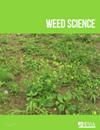野生萝卜对HPPD抑制除草剂的田间抗性鉴定
IF 2.5
2区 农林科学
Q2 AGRONOMY
引用次数: 1
摘要
摘要在过去的十年里,澳大利亚小麦(Triticum aestivum L.)作物对多重抗性野生萝卜(Raphanus raphanistrum L.)种群的控制依赖于4-羟基苯基丙酮酸双加氧酶(HPPD)抑制剂。在最初的大规模筛选试验中,两个被鉴定为对吡喃磺基甲苯+溴氧基尼尔具有抗性的萝卜花群体被鉴定并证实,当植物在4叶期处理时,其对HPPD抑制剂吡喃磺酰基甲苯的敏感性是易感对照群体的5至8倍(LD50值的比较)。两个对吡喃磺基甲苯抗性群体对共同形成的除草剂混合物吡喃磺基甲苯+溴苯氧基腈表现出高达4倍的抗性,并且在羽化后对甲基三酮和顶框酮分别表现出高至9倍和11倍的交叉抗性。在最初收集到一个怀疑具有耐药性的种群的田地里进行了一个小区试验。吡嘧磺酰脲+溴氧腈或托吡酮+溴氧尼尔在羽化后应用可降低萝卜霉菌的控制率(79%至87%),而甲基三酮在羽化前应用的有效性>99%。我们在这里报道了第一例萝卜中对HPPD抑制除草剂的田间抗性,这是由于12年来对这种作用模式的持续依赖引起的。要想缓解连续免耕种植中的除草剂耐药性,需要通过交替和混合多个作用位点、使用早熟除草剂以及确保在最敏感的植物生长阶段使用出苗后除草剂来不断优化除草剂技术。本文章由计算机程序翻译,如有差异,请以英文原文为准。
Identification of Field Resistance to HPPD-Inhibiting Herbicides in Wild Radish (Raphanus raphanistrum)
Abstract The control of multiple-resistant wild radish (Raphanus raphanistrum L.) populations in no-till Australian wheat (Triticum aestivum L.) crops has relied upon 4-hydroxyphenylpyruvate dioxygenase (HPPD)-inhibiting herbicides over the last decade. Two R. raphanistrum populations identified as putatively resistant to pyrasulfotole + bromoxynil in an initial large-scale screening trial were characterized and confirmed to be 5- to 8-fold (comparison of LD50 values) less sensitive than the susceptible control population to the HPPD inhibitor pyrasulfotole when plants were treated at the 4-leaf stage. The two pyrasulfotole-resistant populations exhibited up to 4-fold resistance to the coformulated herbicide mixture pyrasulfotole + bromoxynil and up to 9- and 11-fold cross-resistance to mesotrione and topramezone postemergence, respectively. A small-plot trial was conducted in the field from which of one of the populations suspected of resistance was originally collected. Pyrasulfotole + bromoxynil or topramezone + bromoxynil applied postemergence delivered reduced R. raphanistrum control (79% to 87%), whereas mesotrione applied preemergence was >99% effective. We report here the first case of field resistance to HPPD-inhibiting herbicides in R. raphanistrum, caused by 12 yr of continuous reliance on that mode of action. The mitigation of herbicide resistance in continuous no-till cropping requires a constant optimization of the herbicide technology via alternation and mixtures of multiple sites of action, use of preemergence herbicides, and ensuring postemergence herbicides are applied at the most sensitive plant growth stages.
求助全文
通过发布文献求助,成功后即可免费获取论文全文。
去求助
来源期刊

Weed Science
农林科学-农艺学
CiteScore
4.60
自引率
12.00%
发文量
64
审稿时长
12-24 weeks
期刊介绍:
Weed Science publishes original research and scholarship in the form of peer-reviewed articles focused on fundamental research directly related to all aspects of weed science in agricultural systems. Topics for Weed Science include:
- the biology and ecology of weeds in agricultural, forestry, aquatic, turf, recreational, rights-of-way and other settings, genetics of weeds
- herbicide resistance, chemistry, biochemistry, physiology and molecular action of herbicides and plant growth regulators used to manage undesirable vegetation
- ecology of cropping and other agricultural systems as they relate to weed management
- biological and ecological aspects of weed control tools including biological agents, and herbicide resistant crops
- effect of weed management on soil, air and water.
 求助内容:
求助内容: 应助结果提醒方式:
应助结果提醒方式:


